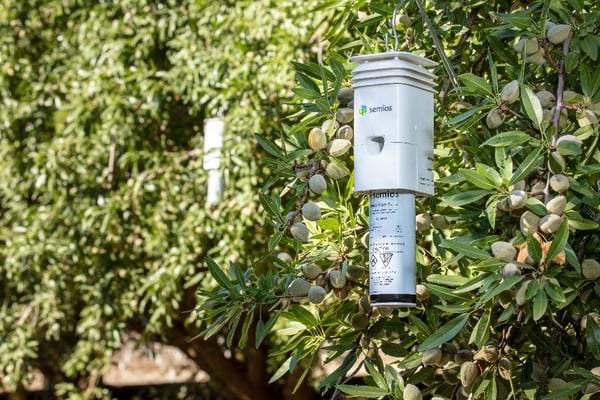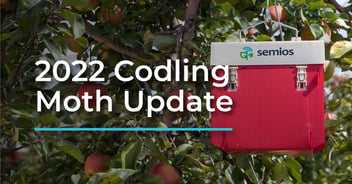As pest development progresses, here are some answers to your top questions related to Navel Orangeworm (NOW) activity.

Did you have your navel orangeworm mating disruption up in March?
Early flight activity this year has been high compared to historical averages and egg laying was considerably earlier than prior seasons.
At our research sites in Firebaugh and Huron, egg laying started in March. From discussing with others in the industry, this was not an uncommon occurrence this season.
It is common practice for some mating disruption products to be installed between April 1 – April 15, however this year’s navel orangeworm (NOW) activity is an example of why Semios pheromone dispensing schedules began on March 8th.
Fig 1. Total adult captures from pheromone traps (orange solid line) and average number of eggs found in egg traps (blue bars) at a site in Firebaugh.
Fig 2. Total adult captures from pheromone traps (orange solid line) and average number of eggs found in egg traps (blue bars) at a site in Huron.
Why did early NOW activity seem so heavy this year?
This year is a bit of a perfect storm of environmental and cultural factors which have led to a scenario where, on average, there are more mummies in the tree, with a higher infestation rate, with decreased winter mortality of NOW due to a milder, drier winter.
Typical late season activity in 2021 erupted during the onset of almond harvest where chemical management logistics become a challenge.
As almonds are removed from the field, pressure increases on pistachios as the next available host. So, although we see pressure up across the board, we are specifically observing higher pressure so far in pistachios.
Fig 3. Adult pheromone trap capture comparison between 2020 and 2021 in non-mating disrupted blocks.
Fig 4. Adult pheromone trap capture comparison between 2020 and 2021 in non-mating disrupted blocks.
Anecdotally, pistachio bloom seemed to have been a bit off last season, which may have led to considerably more variability in nut development and in some cases, nuts still being green at harvest.
This situation leads to a decrease in harvest efficiency and provides a great mummy nut environment for NOW.
Based on model predictions of 1% hull split for nonpareils however, it appears that per acre variation across a block was relatively similar between seasons with the average variation in initiation seen in a block at around 4 calendar days.
With the above issues, we may have had lower than normal harvest efficiency, which leads to more mummies in the tree on average and, when combined with the drier winter we had this year, mortality of the overwintering population was reduced.
How you can leverage Semios to help with this surge in NOW activity
- Setting your biofix and creating degree day alerts help you ensure applications are at the right time.
- Hull split prediction tool helps you know when and where your crop will be most vulnerable.
- Water budgeting tools help you optimize applications to offset costs of management
Related Posts - Understanding Variable Rate Mating Disruption



